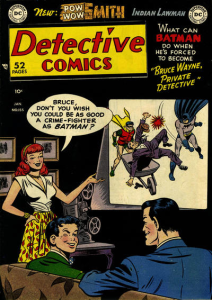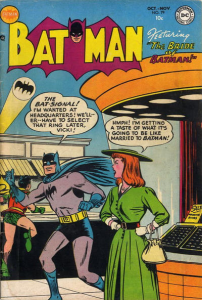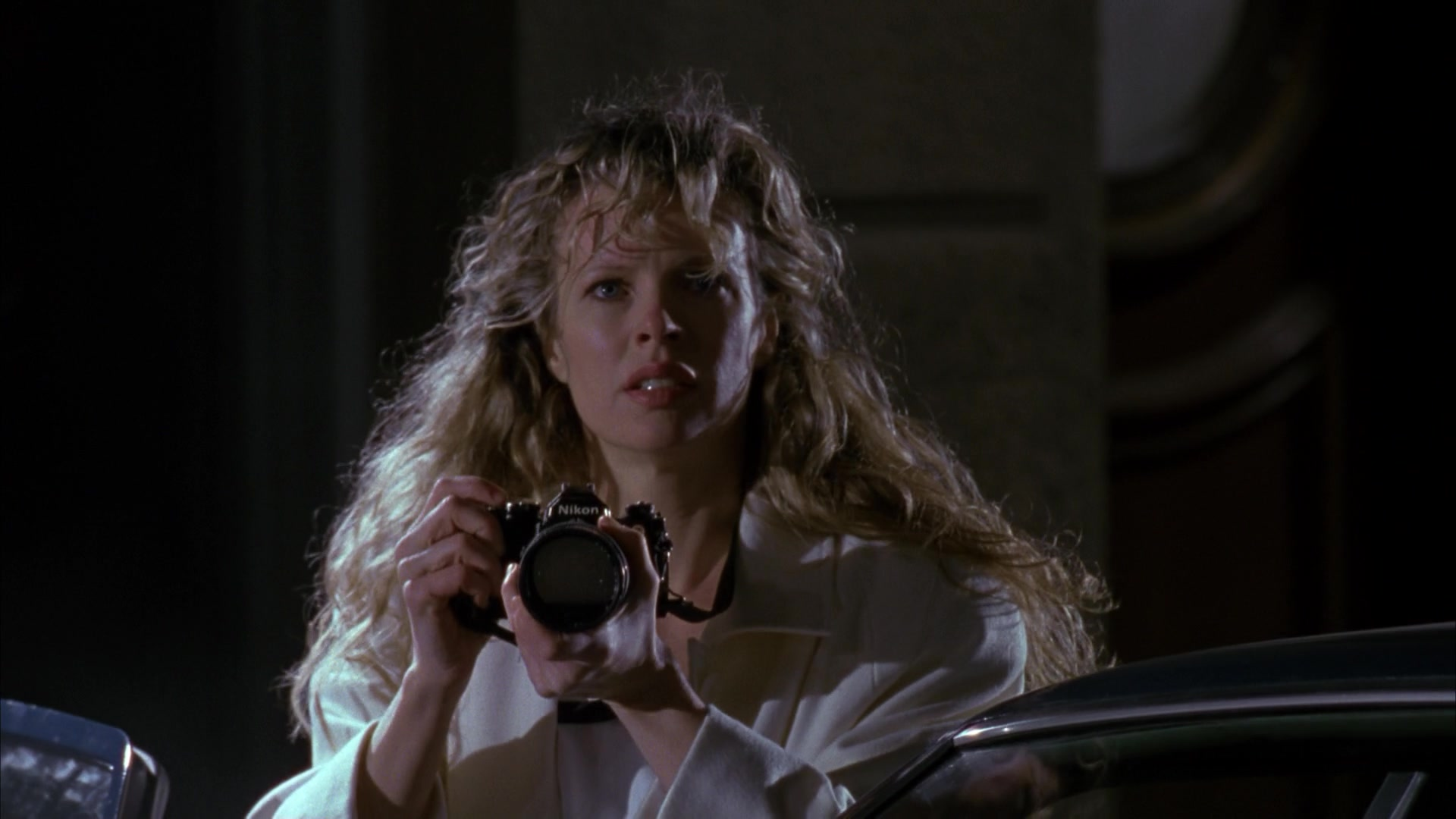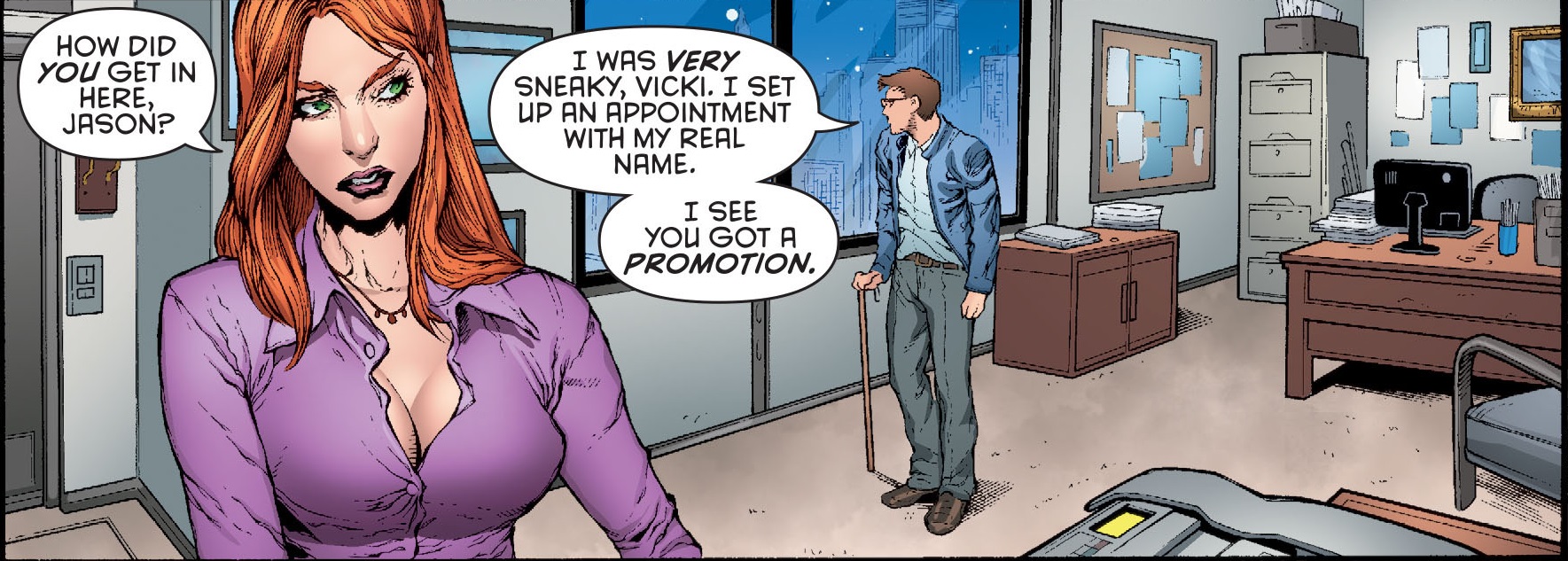Among the fascinating things about Batman comics is the fact that, because they have been going on for eight decades, you get to trace social and aesthetic evolutions on all sorts of fronts. One of those fronts is the way women are depicted, which can be seen in the transformations that the various recurring female members of the cast have gone through. The case of Vicki Vale is particularly illustrative, I think, because she has remained confined to a similar type of supporting role (unlike, say, Selina Kyle or Talia al Ghul), so you get to assess the range of depictions given to a very specific character type.
The love interest/snoopy reporter (in this case, photojournalist) who is out to expose the protagonist’s secret identity is a standard superhero trope, made famous by Lois Lane and brilliantly deconstructed in Astro City: Local Heroes #2. Created by Bill Finger, Bob Kane, and Lew Sayre Schwartz – and first introduced in Batman #49 (cover-dated October 1948) – Vicki Vale was a rip-off character from the start, yet artists managed to give her some panache precisely through the way she looked, most notably her striking red hair (made all the more memorable by the fact that it was often placed in contrast with green garments).
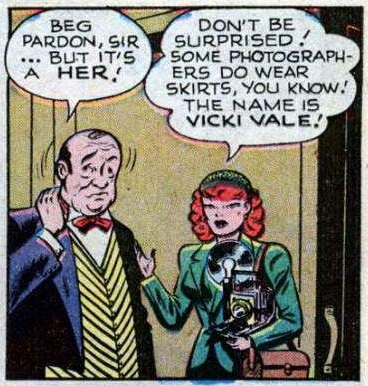 Batman #49
Batman #49
In Vicki Vale’s debut story – the delightful Mad Hatter farce ‘The Scoop of the Century!’ – her style and overall characterization had a bit of a Hildy Johnson (from Howard Hawks’ His Girl Friday) thing going on. The Hawksian connection makes sense, since her role in Batman’s life is comparable to that of many women in Hawks’ screwball comedies (Bringing Up Baby, Ball of Fire, I Was a Male War Bride, Monkey Business, Man’s Favorite Sport?), i.e. a playful foil for men’s self-important professionalism and seriousness.
That said, you could also catch traces of film noir’s femme fatales (in all their diversity), even though Vicki Vale wasn’t exactly a manipulative temptress (or, at least, not a deadly one). Artists Lew Schwarz and Dick Sprang – both inked by Charles Paris – seemed influenced by actresses like Audrey Totter and Rita Hayworth when they drew her in the early 1950s:
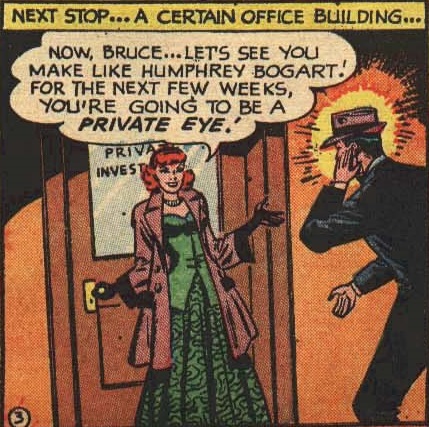 Detective Comics #155
Detective Comics #155
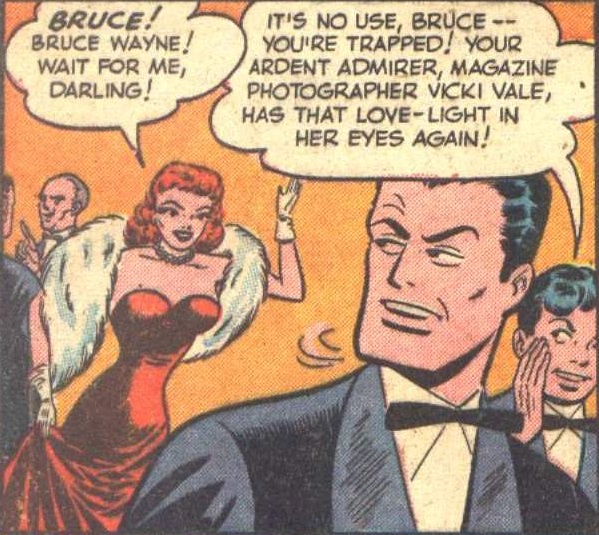 Batman #64
Batman #64
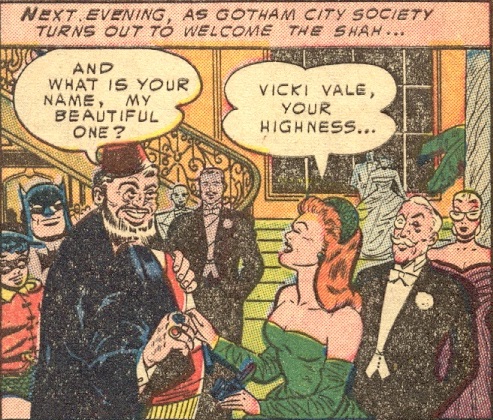 Batman #79
Batman #79
Soon, however, the moralist supervision of the Comics Code Authority – the industry’s self-censorship body, formed in 1954 – took its toll. By the early 1960s, Sheldon Moldoff was drawing Vicki Vale as a much more wholesome figure:
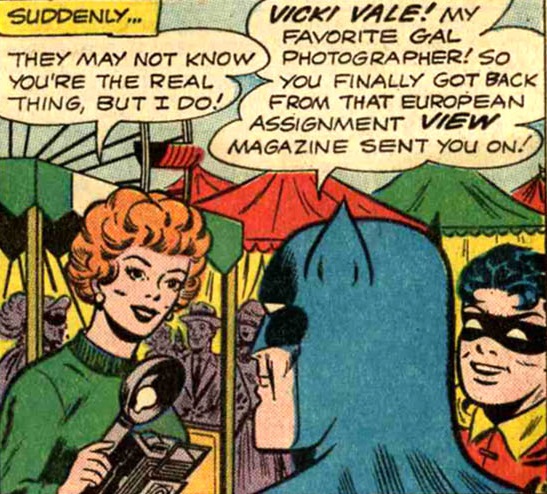 Detective Comics #309
Detective Comics #309
Vicki Vale was temporarily purged from Batman comics in 1964, when editor Julie Schwarz tried to move the Caped Crusader away from his many Silver Age trappings. To be fair, while it’s fun to see the Dark Knight go to outlandish lengths to protect his secret, I suppose there are only so many times you can go to that well with the same character before she starts to look like too much of a fool.
When Vicki Vale occasionally popped up again, she kept variations of a conservative look, albeit with some modern nuances, adjusting to fashion and shifting moral standards. Although no longer an unabashed sexpot, Vale was still nevertheless graceful and charming, in a classy way. Here is how Carl Potts and the great Don Newton drew her in 1977 and 1982, respectively:
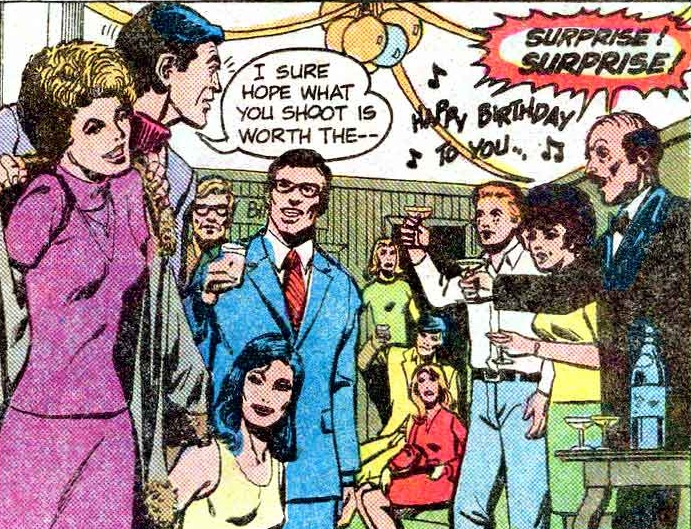 Batman Family #11
Batman Family #11
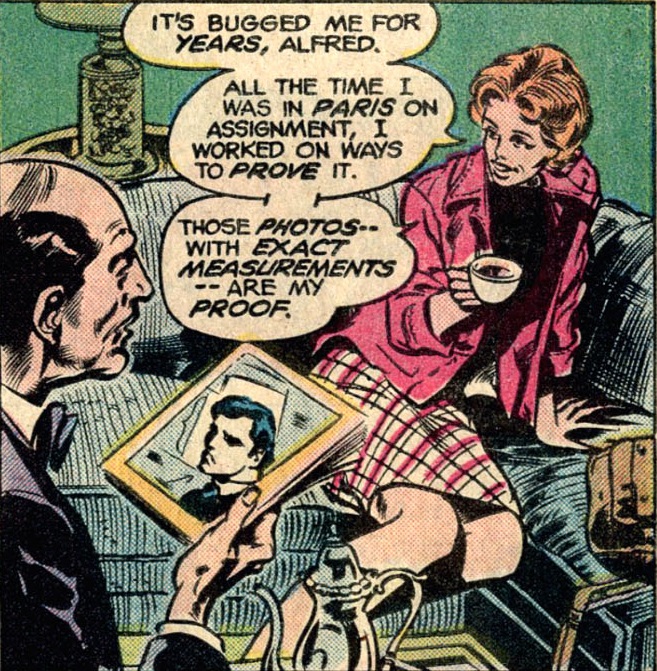 Detective Comics #515
Detective Comics #515
Notice how colorists Bob LeRose and Adrienne Roy (one of my all-time favorite colorists) gave Vicki Vale’s wardrobe a purple and pink motif, in tune with traditional notions of womanhood.
That said, by the 1980s things were beginning to change again. During Gerry Conway’s and Doug Moench’s excellent runs in Batman and Detective Comics, Vicki Vale became a regular cast member. She actually got some of her best stories – and richer characterization – during this period, playing a key part in a mayoral election, getting promoted to editor of Picture News magazine, and at one point taking a leave of absence in order to do field work in Guatemala (she went there looking for Soviets and ended up finding something much scarier – the Joker!).
It was also in 1982 that, under Gene Colan’s groovy pencils and Klaus Janson’s deft inks, Vicki Vale’s style turned much more casual. Between Adrienne Roy’s pink tones, the bracelets, the perm, and the proto-punk looseness, I would say there were hints of early Madonna here…
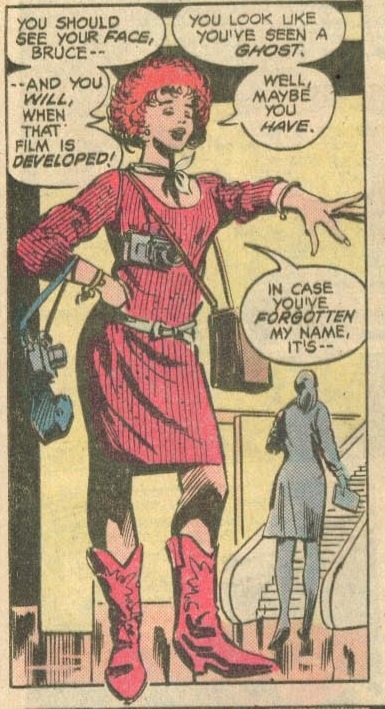 Batman #344
Batman #344
That said, Vicki Vale wasn’t exactly edgy. Sure, she hit a guy who harassed her (Detective Comics #526) and she enthusiastically fired a machine gun in that kickass Guatemala tale (Detective Comics #532), but I don’t want to overstate things. At the end of the day, by and large most of Don Newton’s and Gene Colan’s images of Vicki Vale during this period wouldn’t look out of place on a promo for the then-popular TV series Dynasty – which makes sense, since many of her storylines were soap opera-worthy, especially the love triangle with Bruce Wayne and Catwoman… followed by one involving Nocturna… and then another one, involving Alfred’s daughter…
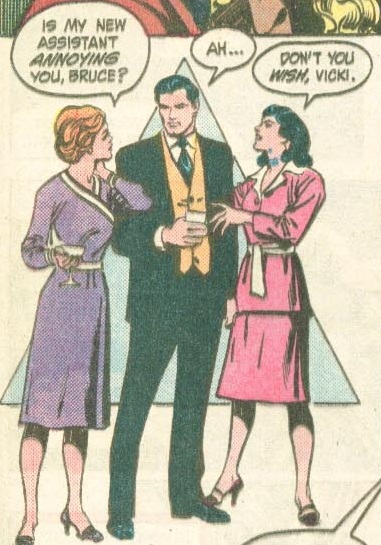 Batman #376
Batman #376
(Subtle background, right?)
My favorite 1980s’ time capsule consists of a subplot about Vicki Vale going to the gym. In comics from 1985, the fitness craze was clearly treated as a new phenomenon and Doug Moench had some fun at the expense of the neoliberal, New Age-tinged attitude and rhetoric that went along with this trend.
I’m not sure whether this next page was illustrated by Rick Hoberg or Chuck Patton (they both get art credits in the issue), but it sure nails the emergence of a new kind of athletic femininity:
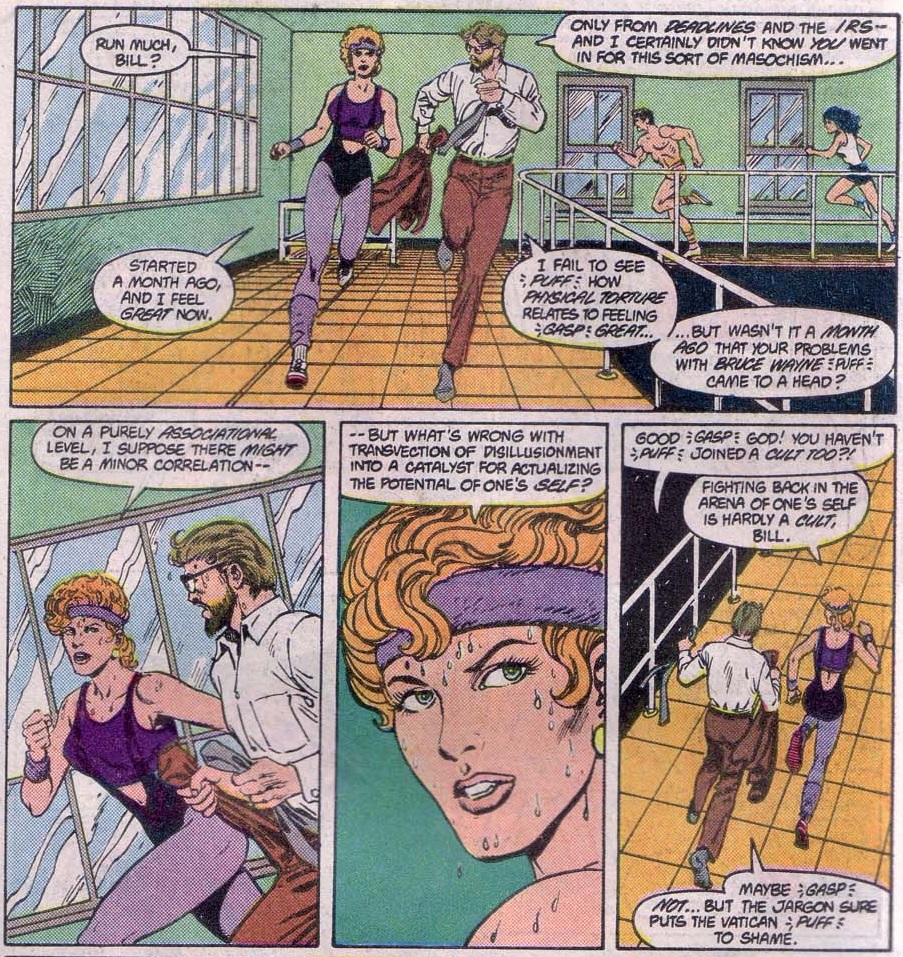 Batman #385
Batman #385
It’s odd to see how much space was devoted to Vicki Vale’s body-changing workout. What started out like a semi-satirical jab at Jane Fonda turned into a homage to a type of muscular female beauty, the kind personified by Brigitte Nielsen – and, eventually, sort of embodied in the characters played by Sigourney Weaver in Aliens and Linda Hamilton in Terminator 2: Judgment Day.
Tom Mandrake showed off this new, more androgynous physique in a scene colored by Adrienne Roy, who now gave Vicki’s outfit a masculine-coded blue:
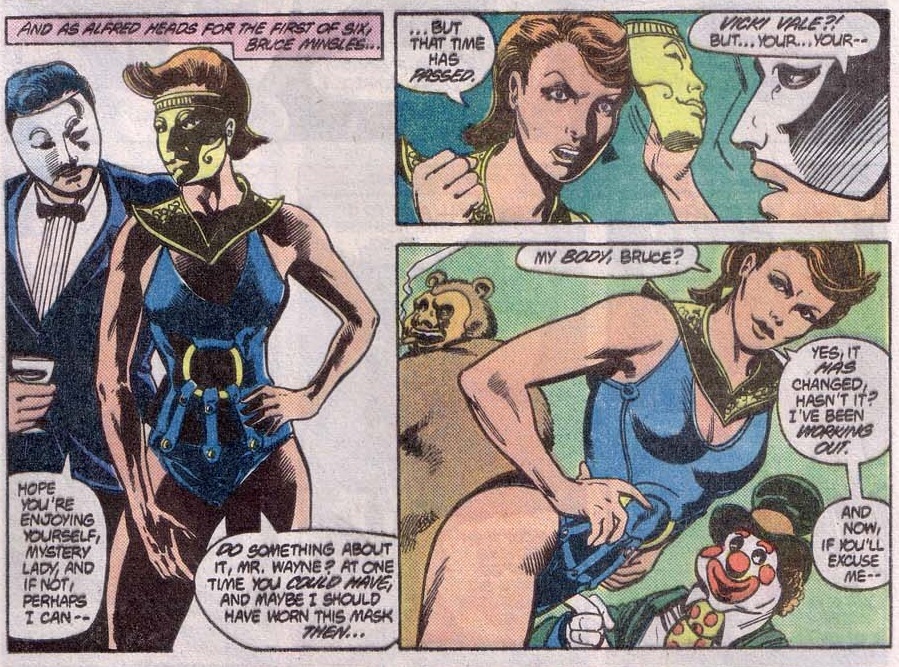 Batman #387
Batman #387
(Another way to look at that blue and yellow combination is that it evokes Batman’s own colors, thus placing the two characters at a more equal level.)
The change did not last long, though. Soon, the butch haircut and imposing posture reverted to a more conventional look – instead of projecting physical strength, Vicki Vale went back to projecting mostly elegance and sophistication.
Indeed, in the post-Crisis reboot, Vicki Vale looked like the prototype of an American, Reagan-era career woman. As an intelligent, emancipated reporter, I suppose it made sense that she appeared to be cut from the same cloth as Murphy Brown.
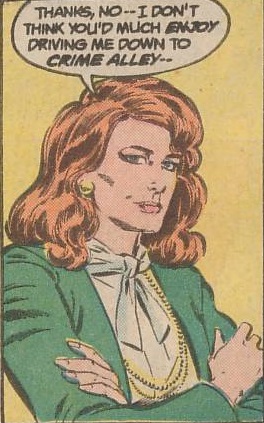 Batman #408
Batman #408
(Yes, the green wardrobe made a comeback as well!)
In an eye-popping 1989 pin-up, Steve Bove gave Vicki Vale another 1980s’ trademark: voluminous, ultra-wavy hair that seemed to wildly envelop her face. Add to that the makeup, the high heels, and the flirty, voluptuous stance and you’ve got Vicki fully updated to the zeitgeist’s mainstream notion of sexiness, coming across like a glamorous model posing for photos (instead of taking them):
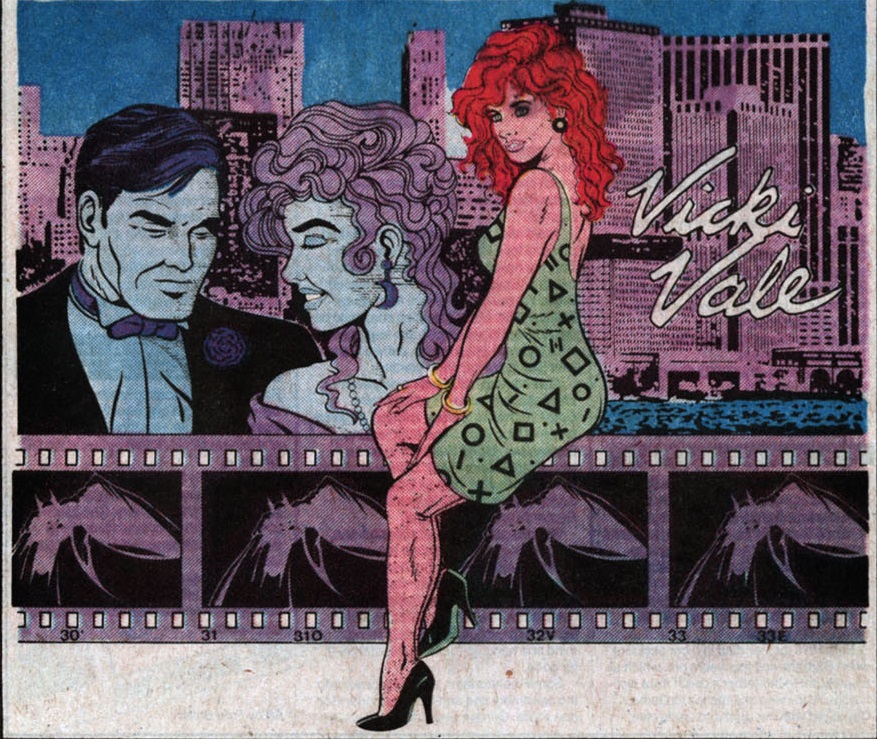 Batman Annual #13
Batman Annual #13
(Despite being an independent working woman, Vicki Vale was never a particularly forceful feminist icon… Still, it does feel somewhat diminishing to see her presented in such a passive pose, deprived of the agency acquired in recent years, her whole attire making her look unfairly objectified and vulnerable.)
Meanwhile, 1989 was also the year that Tim Burton’s Batman movie came out. Vicki Vale, who had quite a prominent role in the film, was played by Kim Basinger…
The fact that Tim Burton went with a sad-eyed blonde – rather than a plucky redhead – was one of his many departures from the comics. It may be taken as part of Burton’s wider attempt to reimagine the Batman mythos through a retro-noirish lens (Basinger does fit that sort of vibe – she even went on to play a Veronica Lake look-alike in the awesome movie L.A. Confidential).
In any case, like several choices in that blockbuster, this one had an impact in the comics, to some degree. While most artists didn’t directly copy Kim Basinger’s facial features (except for Paul Gulacy, in Legends of the Dark Knight #12, because Gulacy always had a thing for including cinematic cameos in his work, especially in his collaborations with notorious film buff Doug Moench), you can find some echoes of Basinger’s looks in the way Jim Aparo and Tom Grindberg approached Vicki Vale at the time.
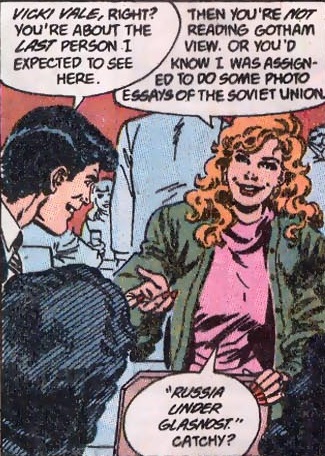 Batman #445
Batman #445
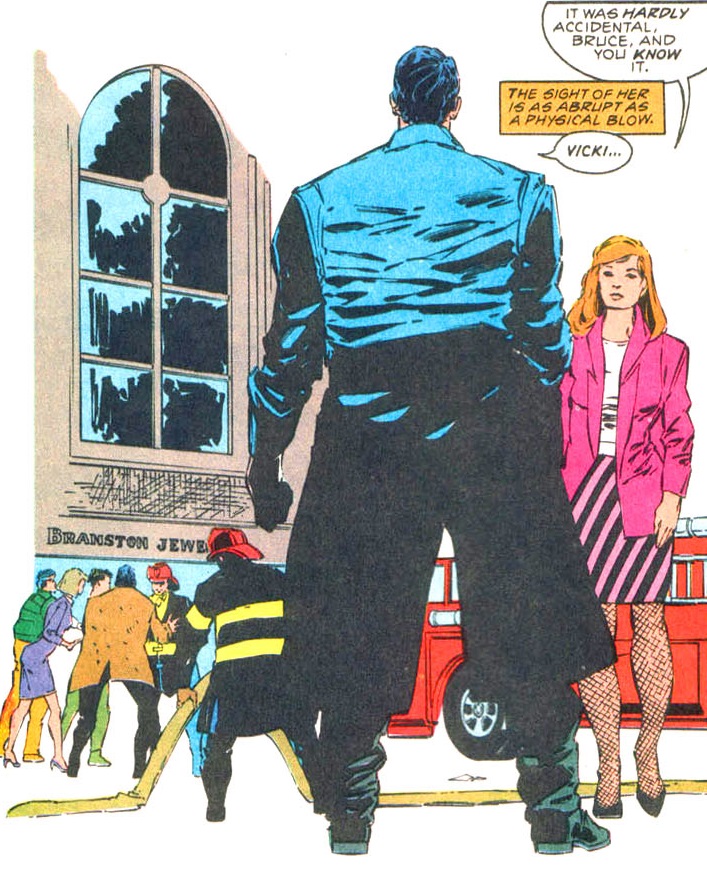 Batman #484
Batman #484
(As you can see, unlike the film’s mostly black and white wardrobe, Adrienne Roy – who didn’t share Burton’s aversion to bright colors – stuck to Vicki’s green and pink sartorial choices.)
Since nobody seemed interested in doing anything original with Vicki Vale, she just went through the loop of being another girlfriend of Bruce Wayne who often got into trouble and ultimately challenged his double life, just like Silver St. Cloud, Julia Remarque, or, later, Vesper Fairchild (all of them fine characters for a while, but given relatively little to do, which is a shame). To be fair, Vicki herself seemed aware of this, getting increasingly sick of being treated like a damsel in distress…
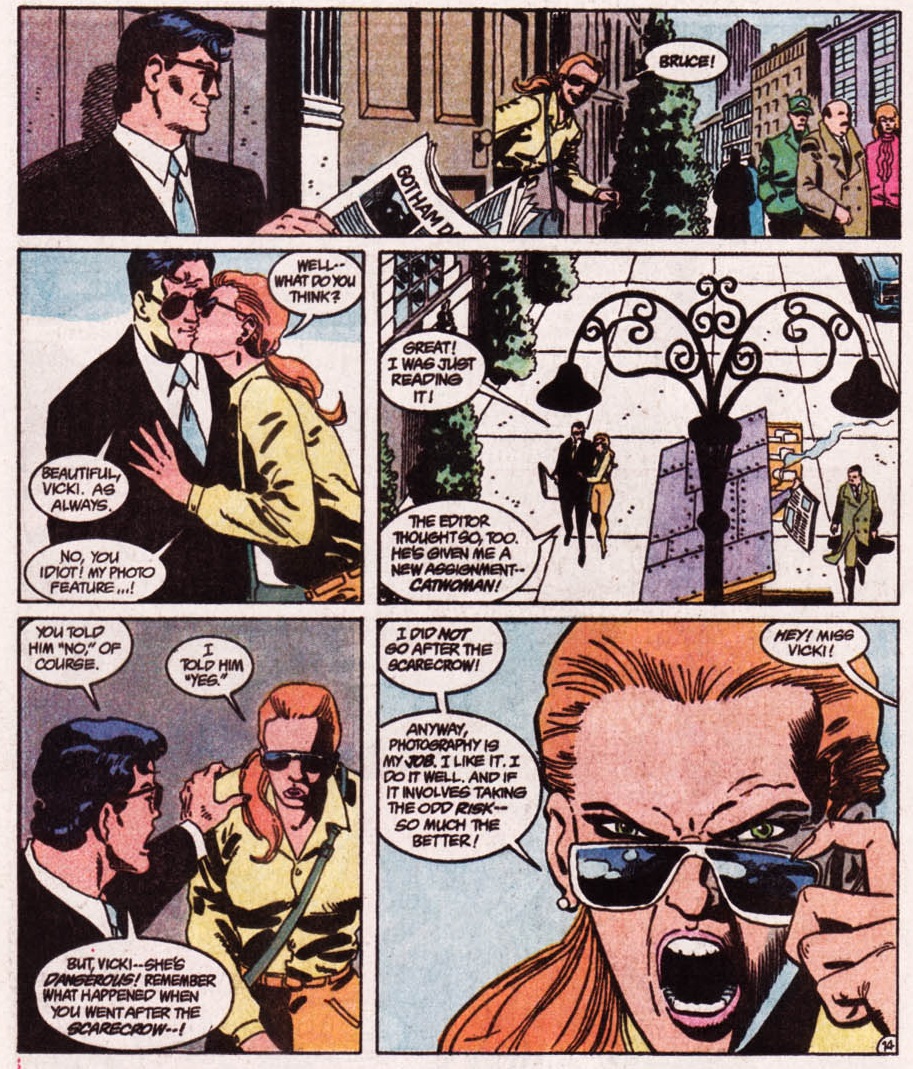 Batman #460
Batman #460
Thus, after a few brief – and repetitive – subplots in the early 1990s, Vicki Vale once again disappeared from the pages of Batman comics.
It took another quasi-hiatus of almost two decades before creators proved ready to revisit her typical storyline (such is the cycle of comics). Indeed, Vicki Vale has made a small comeback in the last decade. Writer Fabien Nicieza helped rescue her from limbo in 2009, at the time of Bruce Wayne’s apparent death in Grant Morrison’s remarkable Batman run. The most striking aspect of Vale’s reboot was that she seemed younger than ever, now oozing a distinctly millennial vibe:
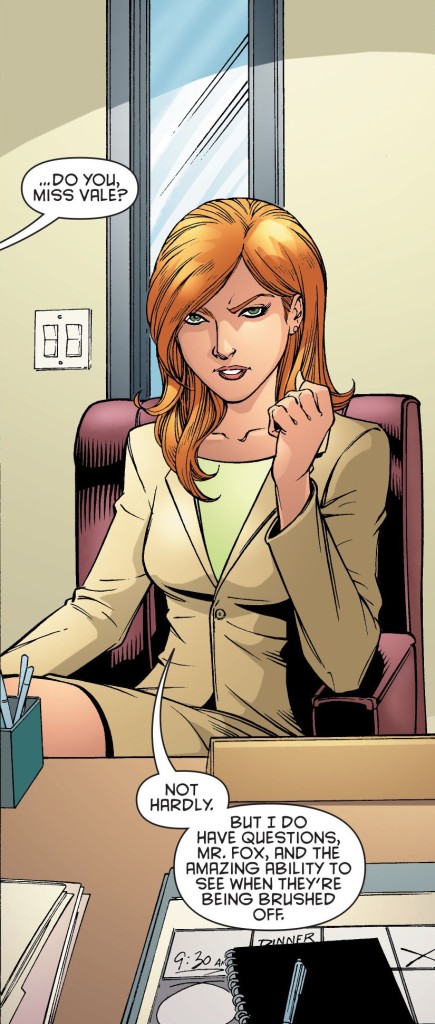 Red Robin #6
Red Robin #6
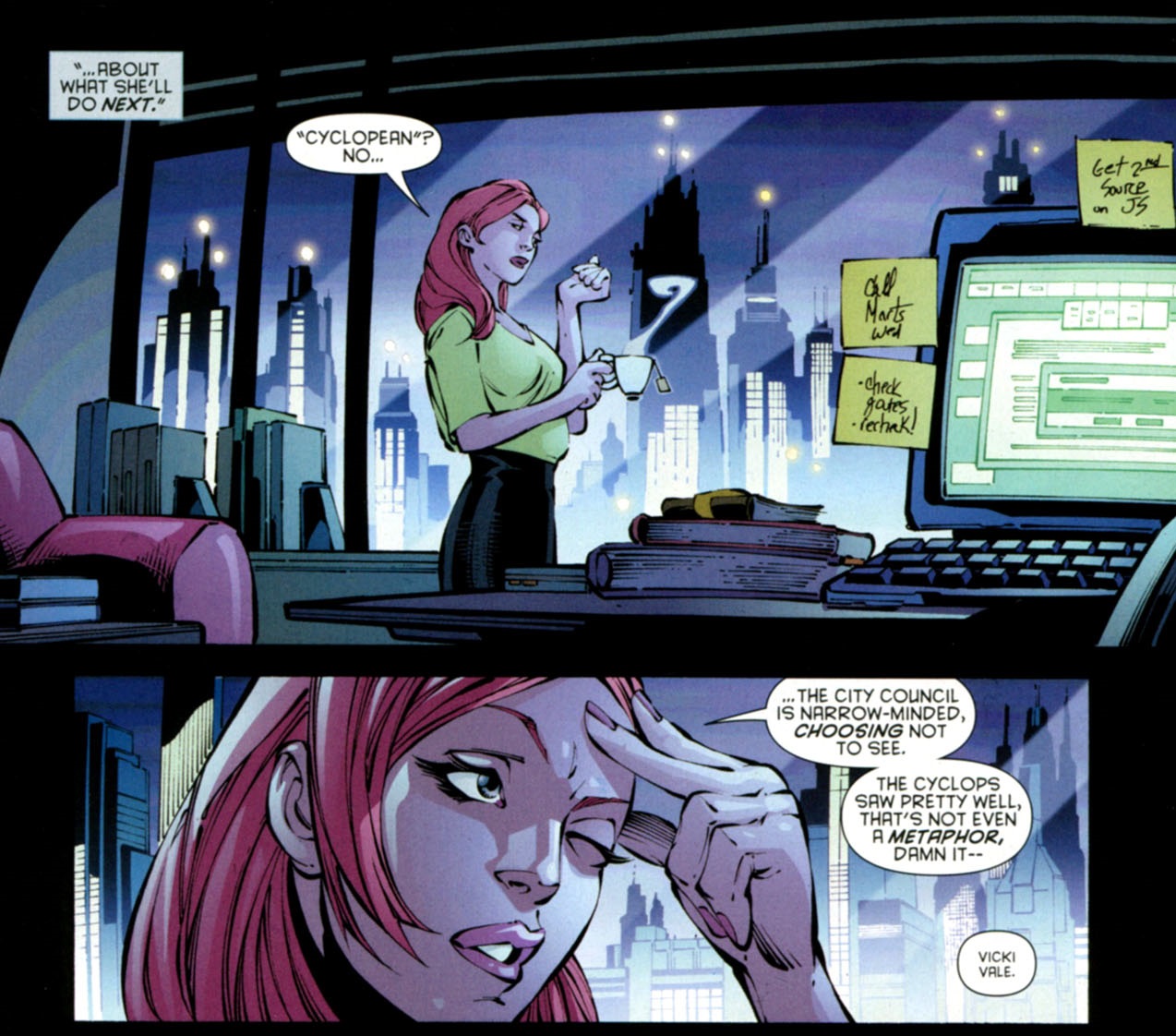 Batman And Robin #18
Batman And Robin #18
I skipped the version of Vicki Vale in 2005’s All-Star Batman and Robin, the Boy Wonder, because that one deserves closer attention…
Frank Miller had already put his spin on Gotham’s favorite reporter in the introduction to the collected edition of Dark Knight Strikes Again, written as a Vicki Vale column about Bruce Wayne’s funeral. In that text piece, she was hilariously out-of-character (it gave the impression that she had lost her marbles or was writing while drunk) and the whole thing devolved into an unsubtle (in an entertaining kind of way) objectivist rant, thus perfectly setting up the tone for the comic that followed.
A younger Vicki then showed up in Miller’s next project set in his gonzo version of the DCU, the infamous All-Star Batman and Robin. Among the many outrageous features of this ridiculously atrocious series was the hyper-sexualization of practically every woman throughout the book. Like with the overall politics and über-gritty attitude, this trait almost suggests a parody of superhero comics – in this case, by taking the leering male gaze to an absurd extreme. However, the whole thing appears to be played with a straight face, which is both baffling and uncomfortable.
Who knows what goes on in Frank Miller’s head anymore, but penciller Jim Lee, inker Scott Williams, and colorist Alex Sinclair sure threw themselves at the sleazy material without a visible trace of irony, especially in this glitzy splash page:
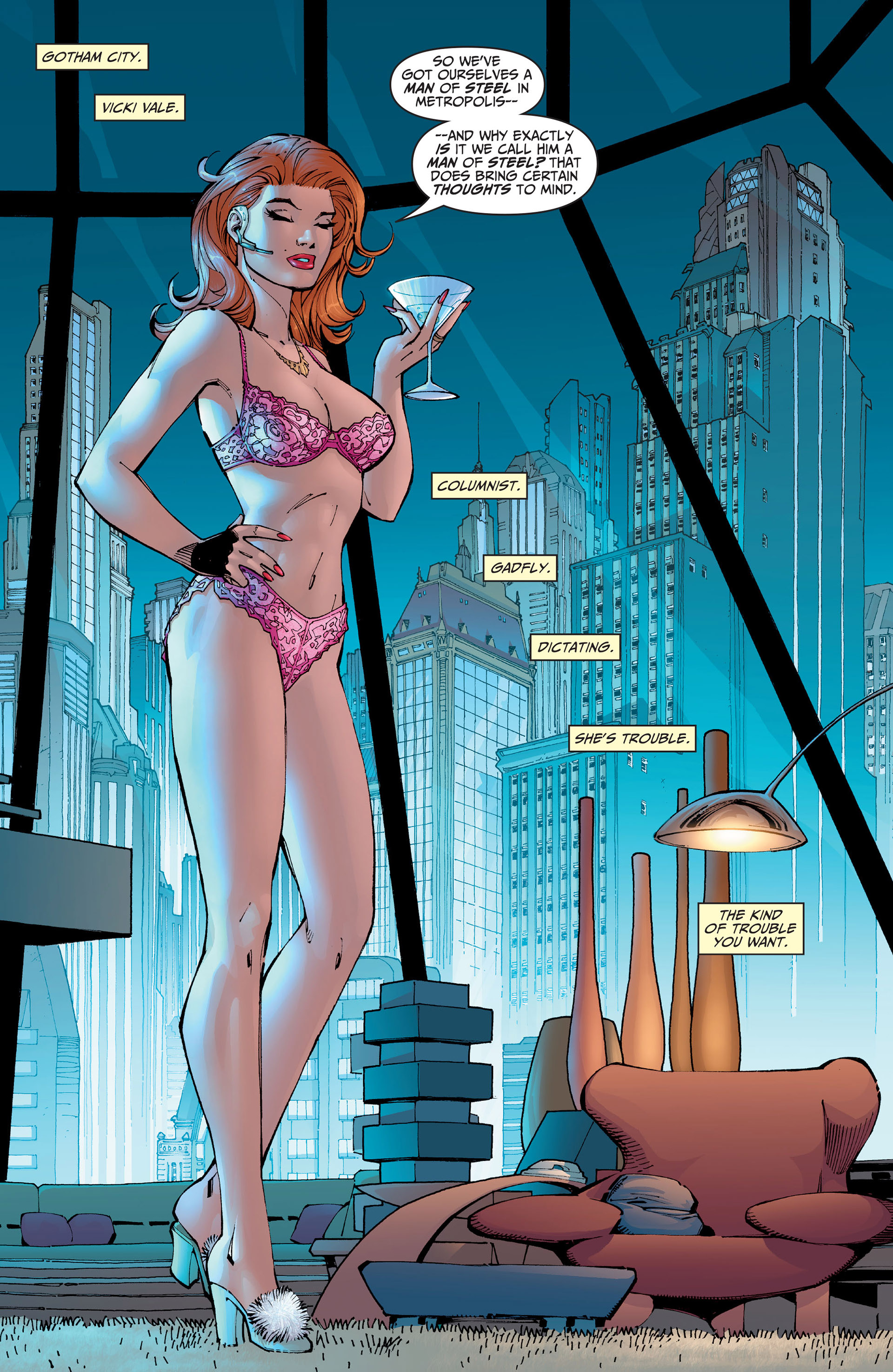 All-Star Batman & Robin the Boy Wonder #1
All-Star Batman & Robin the Boy Wonder #1
And yet, while I don’t think anybody has ever approached the character with such over-the-top levels of softcore sexploitation, Jim Lee was hardly the only artist to give fans a revealing view of Vicki Vale’s slim, sensual body. In fact, Vale’s very first comic, back in pre-Code 1948, provided a generous glimpse:
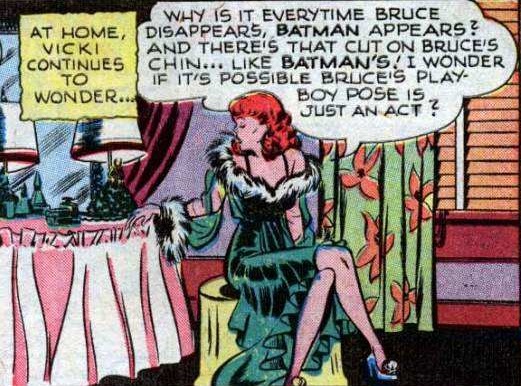 Batman #49
Batman #49
It’s not just that Vicki Vale is always depicted as attractive (you can argue that’s a defining feature of the character, like being a photographer), it’s that a number of (male) creators seem particularly infatuated with her. They are often willing to follow Vale into intimate scenarios, where she is shown with most of her clothes off. Sometimes this is done in a relatively tasteful way, other times less so, but it’s definitely a running motif:
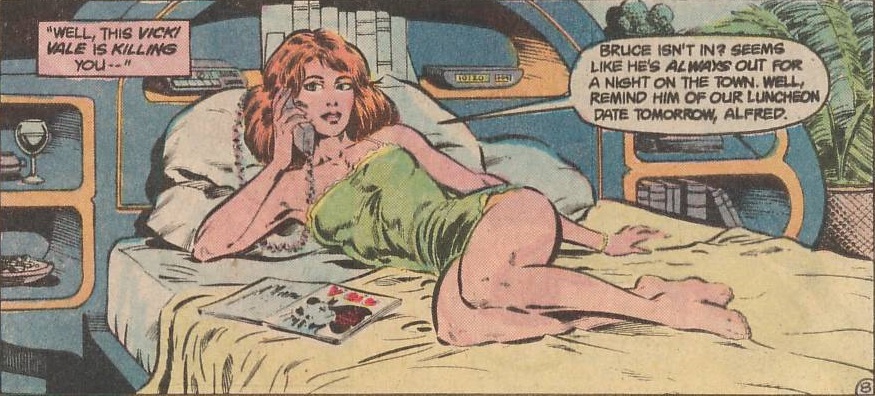 Batman #408
Batman #408
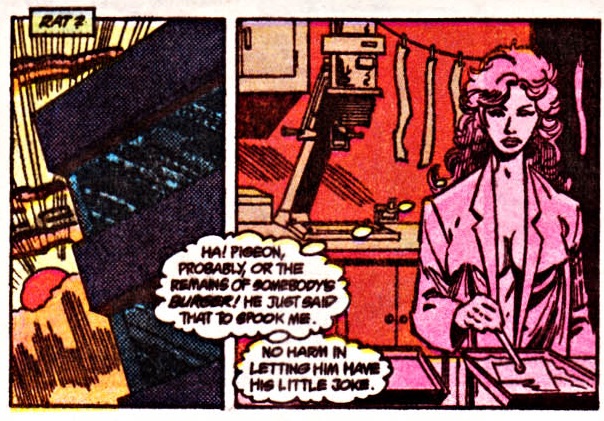 Batman #455
Batman #455
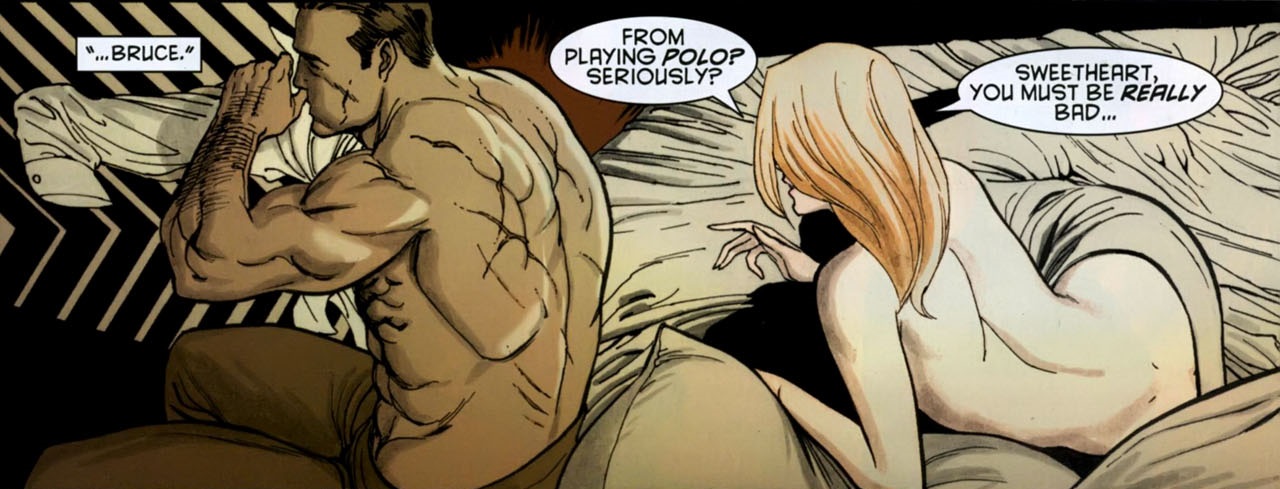 Gotham Gazette – Batman Alive?
Gotham Gazette – Batman Alive?
For the most part, this has been the fate of Vicki Vale – often underwritten, shamefully underused, her looks being her main distinguishing feature… Sure, she was allowed some superficial changes over time (including more intricate stories – and an athletic makeover! – in the mid-80s), but overall she remained largely confined to the same boring character arc.
So, for once, I’ve got to hand it to the ‘New 52’ reboot: at least writer Scott Snyder has tried to give Vicki Vale a more complex and interesting role in the Batman mythos, treating her with greater maturity and nuance. The artists, however, are not necessarily on the same page…

